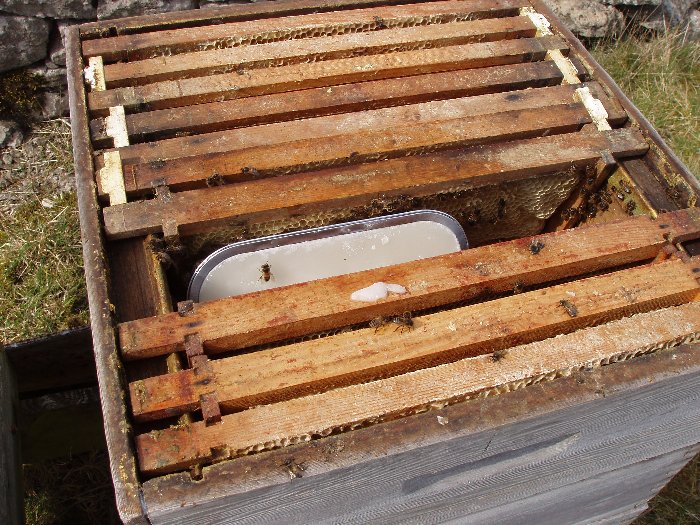Recent mild winters have meant that beekeepers need to think of feeding their bees relatively early in the New Year. Hives had several frames of brood so we need to assume that there may be large numbers of quite active bees that are using the winter stores we fed last autumn and it is time to supplement those stores with candy.
Candy or fondant is recommended at this time of the year rather than sugar syrup, which cannot safely be given until March. Blocks of fondant can be bought from confectionary suppliers but it is also easy to make candy. This recipe comes from Ron Brown’s book ‘Beekeeping A Seasonal Guide’ but I have modified the quantities to suit metric bags of sugar. The candy making is really trouble free if done whilst one is doing other tasks.
| 5kg granulated sugar | |
| 2 ¼ pints/1 litre of water (cold or from the kettle to speed things up) |
This amount fits comfortably in a preserving pan and allows room for the liquid to boil. It produces enough candy for 4 or 5 hives.
- Put the water and sugar in the pan over a medium heat; slowly bring to the boil, stirring the syrup occasionally.
- Boil until it reaches 234 °F (soft ball stage), in reality this temperature is reached 5-10 minutes after the syrup begins to boil and at the point when the foamy syrup settles to a clear, gently boiling liquid.
- Remove the pan from the heat and leave it to stand until the candy begins to set and forms a white streaky mass (160°), this takes a couple of hours but can be hastened by standing the pan in a sink of cold water. Then stir vigorously and pour the mixture into containers to solidify.
To feed the candy to the bees invert a carton of candy over the tops of the frames or over the hole in the crown board. Alternatively, save foil trays and pie dishes and put the setting candy into these. When you remove the crown board watch for which spaces between frames fill with bees and gently lower these slim blocks of candy vertically into these gaps. That way the candy is near the bees and there is no question of having to fuss about with spare empty supers to make space for a carton on top of the hive.
The blocks of candy look unpromising but honey has 18% or 19% water content, slightly less than the solid candy made this way. It does not matter if you feed too soon because the candy does not spoil and will just sit in the hive until the bees need it.
I suspect that having a low threshold for feeding candy is much ‘safer’ than hefting a hive and thinking there are adequate stores and not feeding. Cool winter weather probably greatly reduces the bees’ ability to move laterally in a box of frames and they may never find frames of stores ‘beyond’ the cluster, which always tends to move upwards.
